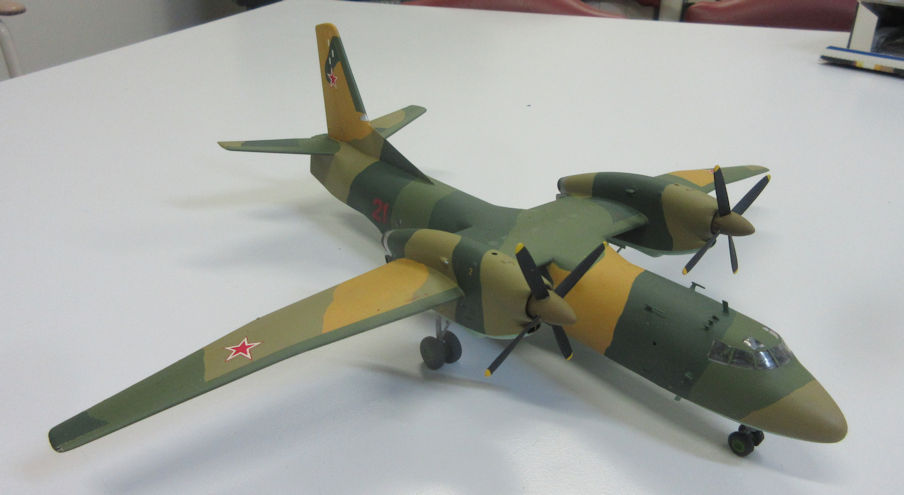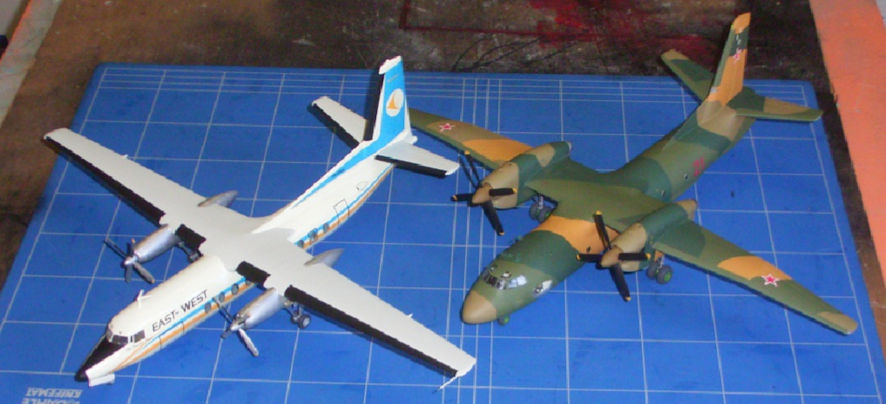February 2008
What I really wanted was a kit of the Antonov An-24 which is the Russian equivalent of the Fokker F27 Friendship. I thought it would be interesting to stand them next to each other to show how different designers came to a similar conclusion when faced by similar aeronautical problems. But since there is not yet a kit of that I settled for a kit of the An-32, which is a development of the earlier aeroplane. So far as I can discover the An-32 is more or less the same size and capacity as the An-24 but with engines set much higher on the wings to avoid foreign object damage on poor quality landing strips, a rear loading ramp and less windows since the An-32 is as much a freighter as a passenger aeroplane.

Amodel kits are not simple affairs. Their larger kits come in large but fragile boxes containing a large number of relatively small sprues, possibly because the moulding machines they use can’t handle bigger parts. The result is that the fuselage comes in six parts, three for each side. The wings comprise seven parts with the engines linking the inner and outer wing sections. The other thing about Amodel kits is that they are not moulded to the great precision we’ve come to expect from the top level manufacturers so that parts fit, but not with the greatest accuracy. The result is that getting the six parts of the fuselage or the various parts of the wings to all line up properly is a challenge and uses a fair bit of filler.
But I’m getting ahead of myself. Amodel seem to operate on the philosophy of providing modellers with four or five tiny pieces where one larger part would have done the job. They also seem to like providing full interiors, which might make sense in a kit like this with the back doors open so people can peer inside at all the little seats along the sides and the overhead crane on its rail running along the top of the cabin. This would be wonderful if you wanted to make a fully detailed model and had the skill and patience to turn all the tiny bits and pieces, most of which need refining, to fit properly and look accurate, into a fully fitted out interior. You might even win a competition with such a kit, but the time it would take and the mental strain of struggling with it all did not appeal to me. Which would have been fine had all the parts that made up the rear doors and ramps fitted well in the closed position. Which they didn’t. I did go to some trouble over the cockpit area because it is easily seen through the windows. All the parts fitted, after a fashion, but it took a fair bit of testing and scraping to get it all to fit inside the fuselage halves when the time came.
After the battle with the fuselage it was time to wage war on the engines and wings. As with the fuselage, nothing quite fitted perfectly although I couldn’t say that assembly was impossible. The kit designers have created the parts in a particular way so that the engines slide onto the ends of the inner wing sections and then the outer sections slide into the other side of the engines. All this is fine if you understand how the parts are supposed to go together and make adjustments to them all before they are set but I did what one would normally do and constructed the engines and outer panels separately and tried to get them to fit when they were dry. It was not the most pleasant modelling experience I’ve ever had.
When I had finally got everything together I began to feel that something looked not right about the model. This might go back to an experience the last time we were in Europe, standing on the tarmac at Budapest Airport and looking at all the lovely Russian airliners which looked somehow broken. It took me a few moments to realize this was because most Russian airliners seem to have anhedral rather than dihedral, which means that their wings point down rather than up. The kit parts, the box illustration and the instructions all suggest that the An-32 wings are straight so I checked on the Airliner web site and found some lovely photos of An-32s in all kinds of colour schemes, but all with a distinct anhedral on the outer wing panels while the inner panels also had a bit of a droop. I was not amused but some drastic surgery with a razor saw solved that problem.

The kit comes with a wide range of decal options but I’ve had some bad experiences with Amodel decals so I decided to cut my losses and go for a simple tactical camouflage scheme that used only a few decals. The decal sheet also provides lots of stencilling, but I only used some of it because the instruction sheet is not as helpful as it could be with some of them. The end result is not a bad looking model but it was not a kit that I enjoyed assembling . I could only recommend it to modellers who are as desperate as I was to have a model of this class of Russian aeroplanes. In fact, remind me again why I make Amodel kits …

Leigh Edmonds little box of stuff
Writing history – making scale models – other stuff